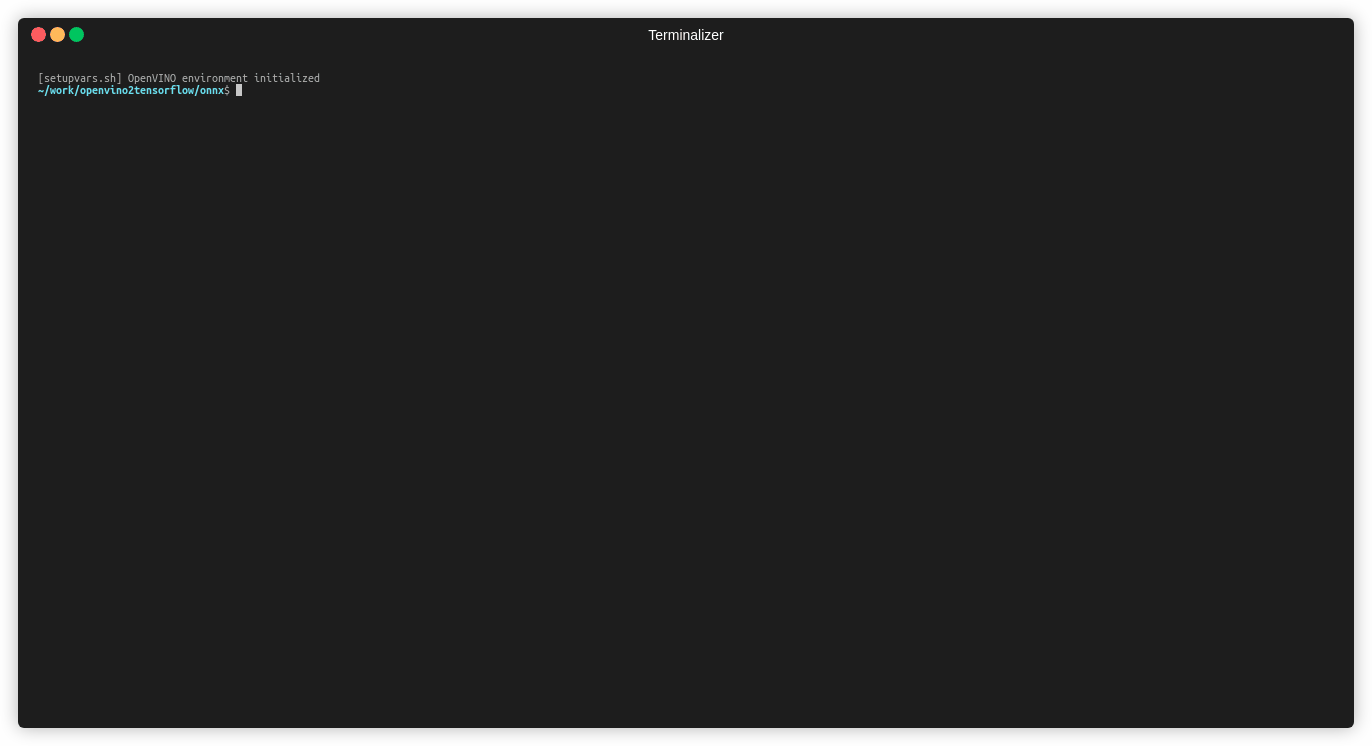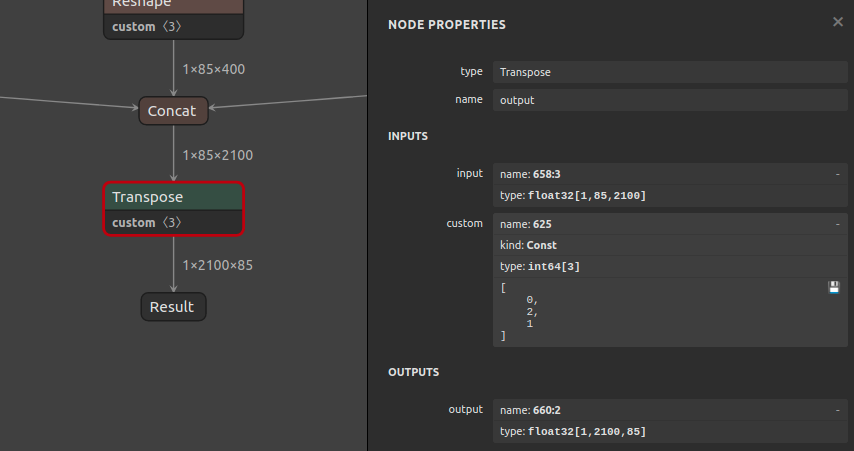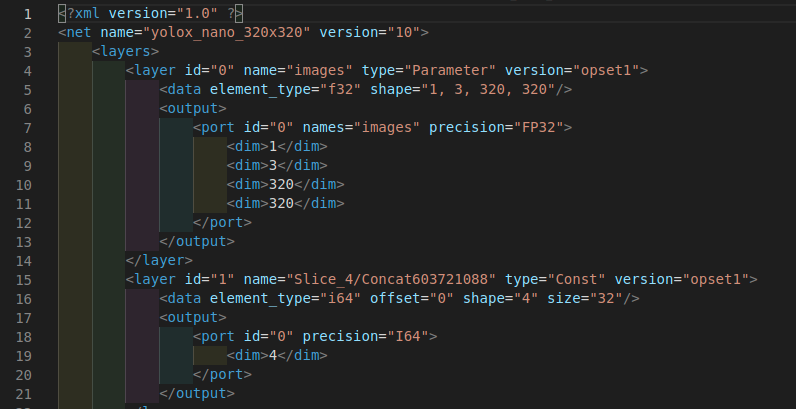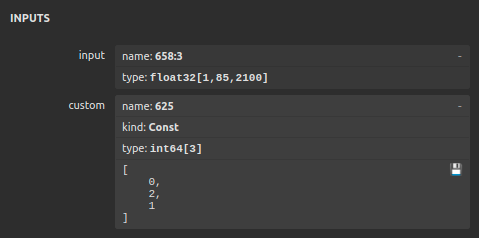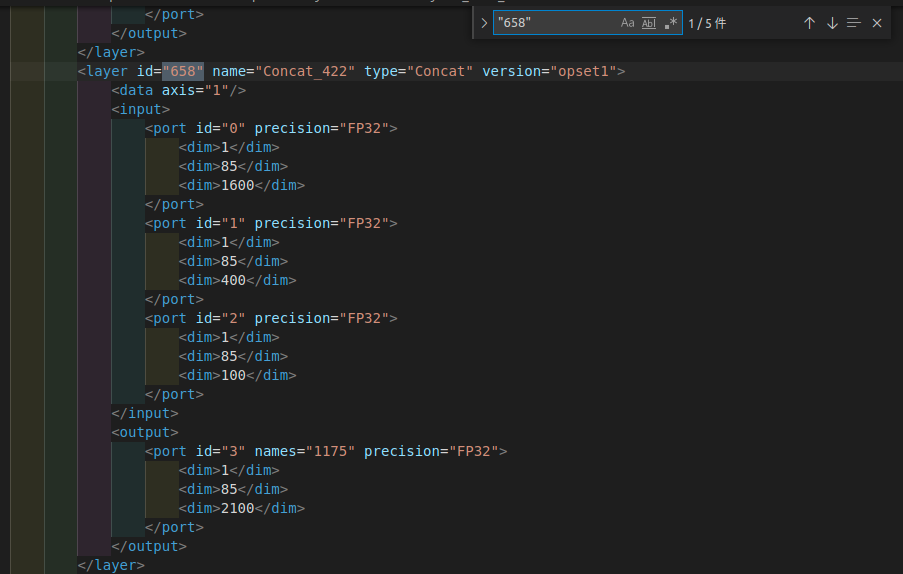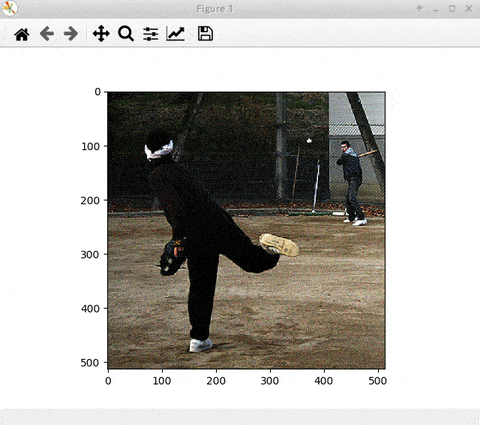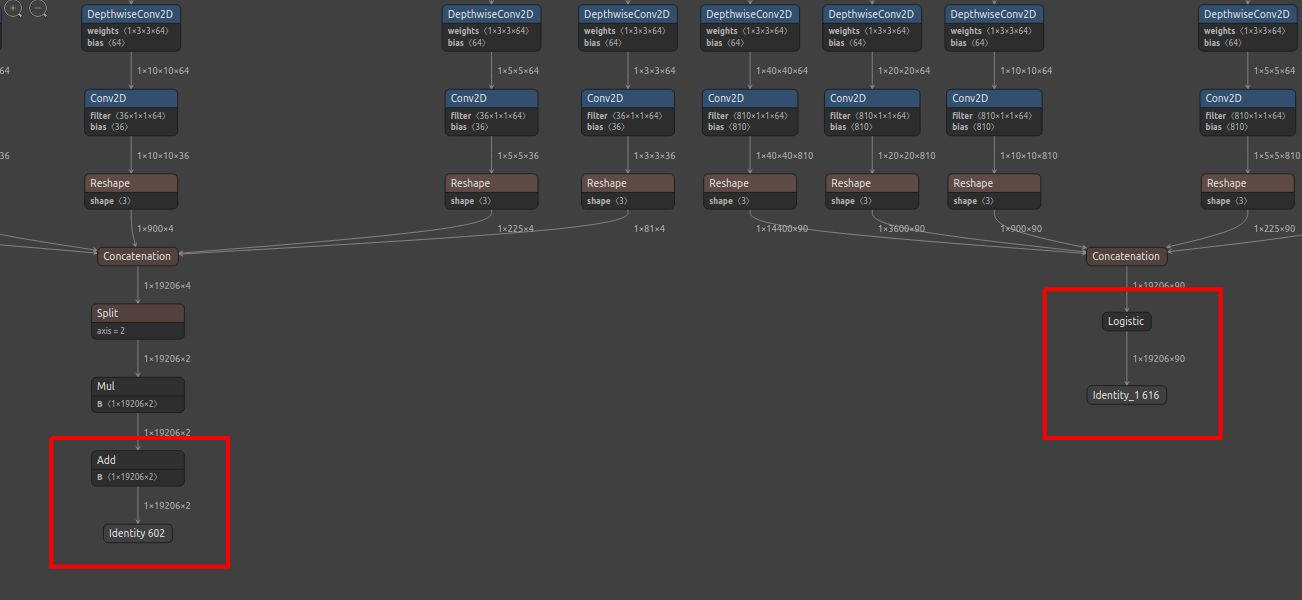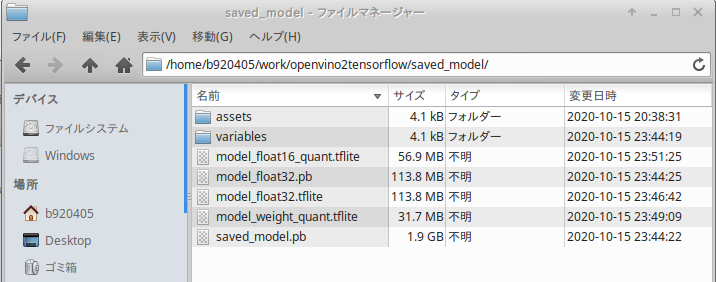This script converts the OpenVINO IR model to Tensorflow's saved_model, tflite, h5 and pb. in (NCHW) format
Project description
openvino2tensorflow
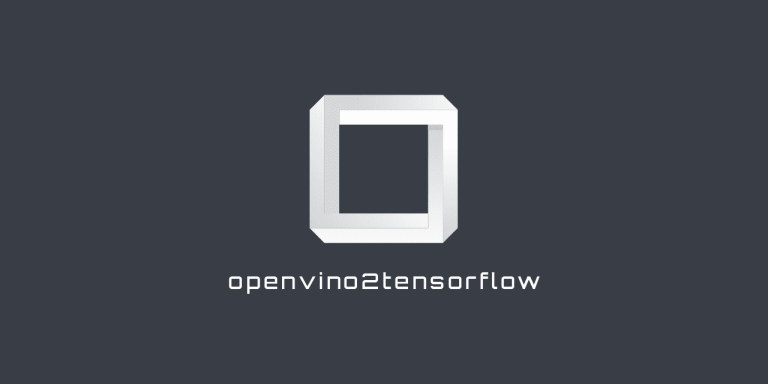
This script converts the ONNX/OpenVINO IR model to Tensorflow's saved_model, tflite, h5, tfjs, tftrt(TensorRT), CoreML, EdgeTPU, ONNX and pb. PyTorch (NCHW) -> ONNX (NCHW) -> OpenVINO (NCHW) -> openvino2tensorflow -> Tensorflow/Keras (NHWC/NCHW) -> TFLite (NHWC/NCHW). And the conversion from .pb to saved_model and from saved_model to .pb and from .pb to .tflite and saved_model to .tflite and saved_model to onnx. Support for building environments with Docker. It is possible to directly access the host PC GUI and the camera to verify the operation. NVIDIA GPU (dGPU) support. Intel iHD GPU (iGPU) support.
Special custom TensorFlow binaries and special custom TensorFLow Lite binaries are used.
Work in progress now.
I'm continuing to add more layers of support and bug fixes on a daily basis. If you have a model that you are having trouble converting, please share the .bin and .xml with the issue. I will try to convert as much as possible.
1. Environment
- Python 3.6+
- TensorFlow v2.7.0+
- PyTorch v1.10.0+
- TorchVision
- TorchAudio
- OpenVINO 2021.4.582+
- TensorRT 8.2+
- trtexec
- pycuda 2021.1
- tensorflowjs
- coremltools
- paddle2onnx
- onnx
- onnxruntime
- onnx_graphsurgeon
- onnx-simplifier
- onnxconverter-common
- onnx-tensorrt
- onnx2json
- json2onnx
- tf2onnx
- torch2trt
- onnx-tf
- tensorflow-datasets
- tf_slim
- edgetpu_compiler
- tflite2tensorflow
- openvino2tensorflow
- gdown
- pandas
- matplotlib
- paddlepaddle
- paddle2onnx
- pycocotools
- scipy
- Intel-Media-SDK
- Intel iHD GPU (iGPU) support
- OpenCL
- Docker
2. Use case
-
PyTorch (NCHW) -> ONNX (NCHW) -> OpenVINO (NCHW) ->
- ->
openvino2tensorflow-> Tensorflow/Keras (NHWC/NCHW) -> TFLite (NHWC/NCHW) - ->
openvino2tensorflow-> Tensorflow/Keras (NHWC/NCHW) -> TFJS (NHWC/NCHW) - ->
openvino2tensorflow-> Tensorflow/Keras (NHWC/NCHW) -> TF-TRT (NHWC/NCHW) - ->
openvino2tensorflow-> Tensorflow/Keras (NHWC) -> EdgeTPU (NHWC) - ->
openvino2tensorflow-> Tensorflow/Keras (NHWC/NCHW) -> CoreML (NHWC/NCHW) - ->
openvino2tensorflow-> Tensorflow/Keras (NHWC/NCHW) -> ONNX (NHWC/NCHW) - ->
openvino2tensorflow-> Myriad Inference Engine Blob (NCHW)
- ->
-
Caffe (NCHW) -> OpenVINO (NCHW) ->
- ->
openvino2tensorflow-> Tensorflow/Keras (NHWC/NCHW) -> TFLite (NHWC/NCHW) - ->
openvino2tensorflow-> Tensorflow/Keras (NHWC/NCHW) -> TFJS (NHWC/NCHW) - ->
openvino2tensorflow-> Tensorflow/Keras (NHWC/NCHW) -> TF-TRT (NHWC/NCHW) - ->
openvino2tensorflow-> Tensorflow/Keras (NHWC) -> EdgeTPU (NHWC) - ->
openvino2tensorflow-> Tensorflow/Keras (NHWC/NCHW) -> CoreML (NHWC/NCHW) - ->
openvino2tensorflow-> Tensorflow/Keras (NHWC/NCHW) -> ONNX (NHWC/NCHW) - ->
openvino2tensorflow-> Myriad Inference Engine Blob (NCHW)
- ->
-
MXNet (NCHW) -> OpenVINO (NCHW) ->
- ->
openvino2tensorflow-> Tensorflow/Keras (NHWC/NCHW) -> TFLite (NHWC/NCHW) - ->
openvino2tensorflow-> Tensorflow/Keras (NHWC/NCHW) -> TFJS (NHWC/NCHW) - ->
openvino2tensorflow-> Tensorflow/Keras (NHWC/NCHW) -> TF-TRT (NHWC/NCHW) - ->
openvino2tensorflow-> Tensorflow/Keras (NHWC) -> EdgeTPU (NHWC) - ->
openvino2tensorflow-> Tensorflow/Keras (NHWC/NCHW) -> CoreML (NHWC/NCHW) - ->
openvino2tensorflow-> Tensorflow/Keras (NHWC/NCHW) -> ONNX (NHWC/NCHW) - ->
openvino2tensorflow-> Myriad Inference Engine Blob (NCHW)
- ->
-
Keras (NHWC) -> OpenVINO (NCHW・Optimized) ->
- ->
openvino2tensorflow-> Tensorflow/Keras (NHWC/NCHW) -> TFLite (NHWC/NCHW) - ->
openvino2tensorflow-> Tensorflow/Keras (NHWC/NCHW) -> TFJS (NHWC/NCHW) - ->
openvino2tensorflow-> Tensorflow/Keras (NHWC/NCHW) -> TF-TRT (NHWC/NCHW) - ->
openvino2tensorflow-> Tensorflow/Keras (NHWC) -> EdgeTPU (NHWC) - ->
openvino2tensorflow-> Tensorflow/Keras (NHWC/NCHW) -> CoreML (NHWC/NCHW) - ->
openvino2tensorflow-> Tensorflow/Keras (NHWC/NCHW) -> ONNX (NHWC/NCHW) - ->
openvino2tensorflow-> Myriad Inference Engine Blob (NCHW)
- ->
-
saved_model ->
saved_model_to_pb-> pb -
saved_model ->
- ->
saved_model_to_tflite-> TFLite - ->
saved_model_to_tflite-> TFJS - ->
saved_model_to_tflite-> TF-TRT - ->
saved_model_to_tflite-> EdgeTPU - ->
saved_model_to_tflite-> CoreML - ->
saved_model_to_tflite-> ONNX
- ->
-
pb ->
pb_to_tflite-> TFLite -
pb ->
pb_to_saved_model-> saved_model
3. Supported Layers
- Currently, there are problems with the
ReshapeandTransposeoperation of 2D,3D,5D Tensor. Since it is difficult to accurately predict the shape of a simple shape change, I have added support for forced replacement of transposition parameters using JSON files. #6-7-replace-weights-or-constant-values-in-const-op-and-add-transpose-or-reshape-or-cast-just-beforeafter-the-operation-specified-by-layer_id
| No. | OpenVINO Layer | TF Layer | Remarks |
|---|---|---|---|
| 1 | Parameter | Input | Convert to NHWC (Default) or NCHW |
| 2 | Const | Constant, Bias | |
| 3 | Convolution | Conv1D, Conv2D, Conv3D | Conv3D has limited support |
| 4 | Add | Add | |
| 5 | ReLU | ReLU | |
| 6 | PReLU | PReLU | Maximum(0.0,x)+Minimum(0.0,alpha*x) |
| 7 | MaxPool | MaxPool2D | |
| 8 | AvgPool | AveragePooling2D | |
| 9 | GroupConvolution | DepthwiseConv2D, Conv2D/Split/Concat | |
| 10 | ConvolutionBackpropData | Conv2DTranspose, Conv3DTranspose | Conv3DTranspose has limited support |
| 11 | Concat | Concat | |
| 12 | Multiply | Multiply | |
| 13 | Tan | Tan | |
| 14 | Tanh | Tanh | |
| 15 | Elu | Elu | |
| 16 | Sigmoid | Sigmoid | |
| 17 | HardSigmoid | hard_sigmoid | |
| 18 | SoftPlus | SoftPlus | |
| 19 | Swish | Swish | You can replace swish and hard-swish with each other by using the "--replace_swish_and_hardswish" option |
| 20 | Interpolate | ResizeNearestNeighbor, ResizeBilinear | 4D [N,H,W,C] or 5D [N,D,H,W,C] |
| 21 | ShapeOf | Shape | |
| 22 | Convert | Cast | |
| 23 | StridedSlice | Strided_Slice | |
| 24 | Pad | Pad, MirrorPad | |
| 25 | Clamp | ReLU6, Clip | |
| 26 | TopK | ArgMax, top_k | |
| 27 | Transpose | Transpose | |
| 28 | Squeeze | Squeeze | |
| 29 | Unsqueeze | Identity, expand_dims | WIP |
| 30 | ReduceMean | reduce_mean | |
| 31 | ReduceMax | reduce_max | |
| 32 | ReduceMin | reduce_min | |
| 33 | ReduceSum | reduce_sum | |
| 34 | ReduceProd | reduce_prod | |
| 35 | Subtract | Subtract | |
| 36 | MatMul | MatMul | |
| 37 | Reshape | Reshape | |
| 38 | Range | Range | WIP |
| 39 | Exp | Exp | |
| 40 | Abs | Abs | |
| 41 | SoftMax | SoftMax | |
| 42 | Negative | Negative | |
| 43 | Maximum | Maximum | No broadcast |
| 44 | Minimum | Minimum | No broadcast |
| 45 | Acos | Acos | |
| 46 | Acosh | Acosh | |
| 47 | Asin | Asin | |
| 48 | Asinh | Asinh | |
| 49 | Atan | Atan | |
| 50 | Atanh | Atanh | |
| 51 | Ceiling | Ceil | |
| 52 | Cos | Cos | |
| 53 | Cosh | Cosh | |
| 54 | Sin | Sin | |
| 55 | Sinh | Sinh | |
| 56 | Gather | Gather | |
| 57 | Divide | Divide, FloorDiv | |
| 58 | Erf | Erf | |
| 59 | Floor | Floor | |
| 60 | FloorMod | FloorMod | |
| 61 | HSwish | HardSwish | x*ReLU6(x+3)*0.16666667, You can replace swish and hard-swish with each other by using the "--replace_swish_and_hardswish" option |
| 62 | Log | Log | |
| 63 | Power | Pow | No broadcast |
| 64 | Mish | Mish | x*Tanh(softplus(x)) |
| 65 | Selu | Selu | |
| 66 | Equal | equal | |
| 67 | NotEqual | not_equal | |
| 68 | Greater | greater | |
| 69 | GreaterEqual | greater_equal | |
| 70 | Less | less | |
| 71 | LessEqual | less_equal | |
| 72 | Select | Select | No broadcast |
| 73 | LogicalAnd | logical_and | |
| 74 | LogicalNot | logical_not | |
| 75 | LogicalOr | logical_or | |
| 76 | LogicalXor | logical_xor | |
| 77 | Broadcast | broadcast_to, ones, Multiply | numpy / bidirectional mode, WIP |
| 78 | Split | Split | |
| 79 | VariadicSplit | Split, Slice, SplitV | |
| 80 | MVN | reduce_mean, sqrt, reduce_variance | (x - reduce_mean(x)) / sqrt(reduce_variance(x) + eps) |
| 81 | NonZero | not_equal, boolean_mask | |
| 82 | ReduceL2 | square, reduce_sum, sqrt | |
| 83 | SpaceToDepth | SpaceToDepth | |
| 84 | DepthToSpace | DepthToSpace | |
| 85 | Sqrt | sqrt | |
| 86 | SquaredDifference | squared_difference | |
| 87 | FakeQuantize | subtract, multiply, round, greater, where, less_equal, add | |
| 88 | Tile | tile | |
| 89 | GatherND | gather_nd, reshape, cumprod, multiply, reduce_sum, gather, concat | |
| 90 | NonMaxSuppression | non_max_suppression | WIP. Only available for batch size 1. |
| 91 | Gelu | gelu | |
| 92 | NormalizeL2 | tf.math.add, tf.math.l2_normalize | x/sqrt(max(sum(x**2), eps)) or x/sqrt(add(sum(x**2), eps)) |
| 93 | ScatterElementsUpdate | shape, rank, floormod, add, cast, range, expand_dims, meshgrid, concat, reshape, tensor_scatter_nd_update | |
| 94 | ROIAlign | crop_and_resize, avg_pool, max_pool | |
| 95 | ScatterNDUpdate | tensor_scatter_nd_update | |
| 96 | GatherElements | rank, add, shape, cast, floormod, range, tensor_scatter_nd_update, constant, transpose, meshgrid, expand_dims, concat, gather_nd | WIP |
| 97 | ConvertLike | Cast | |
| 98 | ReduceL1 | Abs, ReduceSum | |
| 99 | ShuffleChannels | reshape, transpose | |
| 100 | PriorBoxClustered | Constant | WIP |
| 101 | Result | Identity | Output |
4. Setup
4-1. [Environment construction pattern 1] Execution by Docker (strongly recommended)
You do not need to install any packages other than Docker. It consumes 24GB of storage.
$ docker pull ghcr.io/pinto0309/openvino2tensorflow:latest
or
$ docker build -t ghcr.io/pinto0309/openvino2tensorflow:latest .
# If you don't need to access the GUI of the HostPC and the USB camera.
$ docker run -it --rm \
-v `pwd`:/home/user/workdir \
ghcr.io/pinto0309/openvino2tensorflow:latest
# If conversion to TF-TRT is not required. And if you need to access the HostPC GUI and USB camera.
$ xhost +local: && \
docker run -it --rm \
-v `pwd`:/home/user/workdir \
-v /tmp/.X11-unix/:/tmp/.X11-unix:rw \
--device /dev/video0:/dev/video0:mwr \
--net=host \
-e XDG_RUNTIME_DIR=$XDG_RUNTIME_DIR \
-e DISPLAY=$DISPLAY \
--privileged \
ghcr.io/pinto0309/openvino2tensorflow:latest
# If you need to convert to TF-TRT. And if you need to access the HostPC GUI and USB camera.
$ xhost +local: && \
docker run --gpus all -it --rm \
-v `pwd`:/home/user/workdir \
-v /tmp/.X11-unix/:/tmp/.X11-unix:rw \
--device /dev/video0:/dev/video0:mwr \
--net=host \
-e XDG_RUNTIME_DIR=$XDG_RUNTIME_DIR \
-e DISPLAY=$DISPLAY \
--privileged \
ghcr.io/pinto0309/openvino2tensorflow:latest
# If you are using iGPU (OpenCL). And if you need to access the HostPC GUI and USB camera.
$ xhost +local: && \
docker run -it --rm \
-v `pwd`:/home/user/workdir \
-v /tmp/.X11-unix/:/tmp/.X11-unix:rw \
--device /dev/video0:/dev/video0:mwr \
--net=host \
-e LIBVA_DRIVER_NAME=iHD \
-e XDG_RUNTIME_DIR=$XDG_RUNTIME_DIR \
-e DISPLAY=$DISPLAY \
--privileged \
ghcr.io/pinto0309/openvino2tensorflow:latest
4-2. [Environment construction pattern 2] Execution by Host machine
To install using the Python Package Index (PyPI), use the following command.
$ pip3 install --user --upgrade openvino2tensorflow
To install with the latest source code of the main branch, use the following command.
$ pip3 install --user --upgrade git+https://github.com/PINTO0309/openvino2tensorflow
5. Usage
5-1. openvino to tensorflow convert
usage: openvino2tensorflow
[-h]
--model_path MODEL_PATH
[--model_output_path MODEL_OUTPUT_PATH]
[--output_saved_model]
[--output_h5]
[--output_weight_and_json]
[--output_pb]
[--output_no_quant_float32_tflite]
[--output_dynamic_range_quant_tflite]
[--output_weight_quant_tflite]
[--output_float16_quant_tflite]
[--output_integer_quant_tflite]
[--output_full_integer_quant_tflite]
[--output_integer_quant_type OUTPUT_INTEGER_QUANT_TYPE]
[--string_formulas_for_normalization STRING_FORMULAS_FOR_NORMALIZATION]
[--calib_ds_type CALIB_DS_TYPE]
[--ds_name_for_tfds_for_calibration DS_NAME_FOR_TFDS_FOR_CALIBRATION]
[--split_name_for_tfds_for_calibration SPLIT_NAME_FOR_TFDS_FOR_CALIBRATION]
[--download_dest_folder_path_for_the_calib_tfds DOWNLOAD_DEST_FOLDER_PATH_FOR_THE_CALIB_TFDS]
[--tfds_download_flg]
[--load_dest_file_path_for_the_calib_npy LOAD_DEST_FILE_PATH_FOR_THE_CALIB_NPY]
[--output_tfjs]
[--output_tftrt_float32]
[--output_tftrt_float16]
[--tftrt_maximum_cached_engines TFTRT_MAXIMUM_CACHED_ENGINES]
[--output_coreml]
[--output_edgetpu]
[--edgetpu_compiler_timeout EDGETPU_COMPILER_TIMEOUT]
[--edgetpu_num_segments EDGETPU_NUM_SEGMENTS]
[--output_onnx]
[--onnx_opset ONNX_OPSET]
[--output_myriad]
[--vpu_number_of_shaves VPU_NUMBER_OF_SHAVES]
[--vpu_number_of_cmx_slices VPU_NUMBER_OF_CMX_SLICES]
[--replace_swish_and_hardswish]
[--optimizing_hardswish_for_edgetpu]
[--replace_prelu_and_minmax]
[--yolact]
[--restricted_resize_image_mode]
[--weight_replacement_config WEIGHT_REPLACEMENT_CONFIG]
[--disable_experimental_new_quantizer]
[--optimizing_barracuda]
[--layerids_of_the_terminating_output LAYERIDS_OF_THE_TERMINATING_OUTPUT]
[--keep_input_tensor_in_nchw]
optional arguments:
-h, --help
show this help message and exit
--model_path MODEL_PATH
input IR model path (.xml)
--model_output_path MODEL_OUTPUT_PATH
The output folder path of the converted model file
--output_saved_model
saved_model output switch
--output_h5
.h5 output switch
--output_weight_and_json
weight of h5 and json output switch
--output_pb
.pb output switch
--output_no_quant_float32_tflite
float32 tflite output switch
--output_dynamic_range_quant_tflite
dynamic range quant tflite output switch
--output_weight_quant_tflite
weight quant tflite output switch
--output_float16_quant_tflite
float16 quant tflite output switch
--output_integer_quant_tflite
integer quant tflite output switch
--output_full_integer_quant_tflite
full integer quant tflite output switch
--output_integer_quant_type OUTPUT_INTEGER_QUANT_TYPE
Input and output types when doing Integer Quantization
('int8 (default)' or 'uint8')
--string_formulas_for_normalization STRING_FORMULAS_FOR_NORMALIZATION
String formulas for normalization. It is evaluated by
Pythons eval() function.
Default: '(data - [127.5,127.5,127.5]) / [127.5,127.5,127.5]'
--calib_ds_type CALIB_DS_TYPE
Types of data sets for calibration. tfds or numpy
Default: numpy
--ds_name_for_tfds_for_calibration DS_NAME_FOR_TFDS_FOR_CALIBRATION
Dataset name for TensorFlow Datasets for calibration.
https://www.tensorflow.org/datasets/catalog/overview
--split_name_for_tfds_for_calibration SPLIT_NAME_FOR_TFDS_FOR_CALIBRATION
Split name for TensorFlow Datasets for calibration.
https://www.tensorflow.org/datasets/catalog/overview
--download_dest_folder_path_for_the_calib_tfds DOWNLOAD_DEST_FOLDER_PATH_FOR_THE_CALIB_TFDS
Download destination folder path for the calibration
dataset. Default: $HOME/TFDS
--tfds_download_flg
True to automatically download datasets from
TensorFlow Datasets. True or False
--load_dest_file_path_for_the_calib_npy LOAD_DEST_FILE_PATH_FOR_THE_CALIB_NPY
The path from which to load the .npy file containing
the numpy binary version of the calibration data.
Default: sample_npy/calibration_data_img_sample.npy
--output_tfjs
tfjs model output switch
--output_tftrt_float32
tftrt float32 model output switch
--output_tftrt_float16
tftrt float16 model output switch
--tftrt_maximum_cached_engines
Specifies the quantity of tftrt_maximum_cached_engines for TFTRT.
Default: 10000
--output_coreml
coreml model output switch
--output_edgetpu
edgetpu model output switch
--edgetpu_compiler_timeout
edgetpu_compiler timeout for one compilation process in seconds.
Default: 3600
--edgetpu_num_segments
Partition the model into 'num_segments' segments.
Default: 1 (no partition)
--output_onnx
onnx model output switch
--onnx_opset ONNX_OPSET
onnx opset version number
--output_myriad
myriad inference engine blob output switch
--vpu_number_of_shaves VPU_NUMBER_OF_SHAVES
vpu number of shaves. Default: 4
--vpu_number_of_cmx_slices VPU_NUMBER_OF_CMX_SLICES
vpu number of cmx slices. Default: 4
--replace_swish_and_hardswish
Replace swish and hard-swish with each other
--optimizing_hardswish_for_edgetpu
Optimizing hardswish for edgetpu
--replace_prelu_and_minmax
Replace prelu and minimum/maximum with each other
--yolact
Specify when converting the Yolact model
--restricted_resize_image_mode
Specify this if the upsampling contains OPs that are
not scaled by integer multiples. Optimization for
EdgeTPU will be disabled.
--weight_replacement_config WEIGHT_REPLACEMENT_CONFIG
Replaces the value of Const for each layer_id defined
in json. Specify the path to the json file.
'weight_replacement_config.json'
--disable_experimental_new_quantizer
Disable MLIRs new quantization feature during INT8 quantization
in TensorFlowLite.
--optimizing_barracuda
Generates ONNX by replacing Barracuda unsupported layers
with standard layers. For example, GatherND.
--layerids_of_the_terminating_output LAYERIDS_OF_THE_TERMINATING_OUTPUT
A comma-separated list of layerIDs to be used as output layers.
e.g. --layerids_of_the_terminating_output 100,201,560
Default: ''
--keep_input_tensor_in_nchw
Does not convert the input to NHWC, but keeps the NCHW format.
Transpose is inserted right after the input layer, and
the model internals are handled by NHWC. Only 4D input is supported.
5-2. saved_model to tflite convert
usage: saved_model_to_tflite
[-h]
--saved_model_dir_path SAVED_MODEL_DIR_PATH
[--signature_def SIGNATURE_DEF]
[--input_shapes INPUT_SHAPES]
[--model_output_dir_path MODEL_OUTPUT_DIR_PATH]
[--output_no_quant_float32_tflite]
[--output_dynamic_range_quant_tflite]
[--output_weight_quant_tflite]
[--output_float16_quant_tflite]
[--output_integer_quant_tflite]
[--output_full_integer_quant_tflite]
[--output_integer_quant_type OUTPUT_INTEGER_QUANT_TYPE]
[--string_formulas_for_normalization STRING_FORMULAS_FOR_NORMALIZATION]
[--calib_ds_type CALIB_DS_TYPE]
[--ds_name_for_tfds_for_calibration DS_NAME_FOR_TFDS_FOR_CALIBRATION]
[--split_name_for_tfds_for_calibration SPLIT_NAME_FOR_TFDS_FOR_CALIBRATION]
[--download_dest_folder_path_for_the_calib_tfds DOWNLOAD_DEST_FOLDER_PATH_FOR_THE_CALIB_TFDS]
[--tfds_download_flg]
[--load_dest_file_path_for_the_calib_npy LOAD_DEST_FILE_PATH_FOR_THE_CALIB_NPY]
[--output_tfjs]
[--output_tftrt_float32]
[--output_tftrt_float16]
[--tftrt_maximum_cached_engines TFTRT_MAXIMUM_CACHED_ENGINES]
[--output_coreml]
[--output_edgetpu]
[--edgetpu_compiler_timeout EDGETPU_COMPILER_TIMEOUT]
[--edgetpu_num_segments EDGETPU_NUM_SEGMENTS]
[--output_onnx]
[--onnx_opset ONNX_OPSET]
[--disable_experimental_new_quantizer]
optional arguments:
-h, --help
show this help message and exit
--saved_model_dir_path SAVED_MODEL_DIR_PATH
Input saved_model dir path
--signature_def SIGNATURE_DEF
Specifies the signature name to load from saved_model
--input_shapes INPUT_SHAPES
Overwrites an undefined input dimension (None or -1).
Specify the input shape in [n,h,w,c] format.
For non-4D tensors, specify [a,b,c,d,e], [a,b], etc.
A comma-separated list if there are multiple inputs.
(e.g.) --input_shapes [1,256,256,3],[1,64,64,3],[1,2,16,16,3]
--model_output_dir_path MODEL_OUTPUT_DIR_PATH
The output folder path of the converted model file
--output_no_quant_float32_tflite
float32 tflite output switch
--output_dynamic_range_quant_tflite
dynamic range quant tflite output switch
--output_weight_quant_tflite
weight quant tflite output switch
--output_float16_quant_tflite
float16 quant tflite output switch
--output_integer_quant_tflite
integer quant tflite output switch
--output_full_integer_quant_tflite
full integer quant tflite output switch
--output_integer_quant_type OUTPUT_INTEGER_QUANT_TYPE
Input and output types when doing Integer Quantization
('int8 (default)' or 'uint8')
--string_formulas_for_normalization STRING_FORMULAS_FOR_NORMALIZATION
String formulas for normalization. It is evaluated by
Pythons eval() function.
Default: '(data - [127.5,127.5,127.5]) / [127.5,127.5,127.5]'
--calib_ds_type CALIB_DS_TYPE
Types of data sets for calibration. tfds or numpy
Default: numpy
--ds_name_for_tfds_for_calibration DS_NAME_FOR_TFDS_FOR_CALIBRATION
Dataset name for TensorFlow Datasets for calibration.
https://www.tensorflow.org/datasets/catalog/overview
--split_name_for_tfds_for_calibration SPLIT_NAME_FOR_TFDS_FOR_CALIBRATION
Split name for TensorFlow Datasets for calibration.
https://www.tensorflow.org/datasets/catalog/overview
--download_dest_folder_path_for_the_calib_tfds DOWNLOAD_DEST_FOLDER_PATH_FOR_THE_CALIB_TFDS
Download destination folder path for the calibration
dataset. Default: $HOME/TFDS
--tfds_download_flg
True to automatically download datasets from
TensorFlow Datasets. True or False
--load_dest_file_path_for_the_calib_npy LOAD_DEST_FILE_PATH_FOR_THE_CALIB_NPY
The path from which to load the .npy file containing
the numpy binary version of the calibration data.
Default: sample_npy/calibration_data_img_sample.npy
--output_tfjs
tfjs model output switch
--output_tftrt_float32
tftrt float32 model output switch
--output_tftrt_float16
tftrt float16 model output switch
--tftrt_maximum_cached_engines
Specifies the quantity of tftrt_maximum_cached_engines for TFTRT.
Default: 10000
--output_coreml
coreml model output switch
--output_edgetpu
edgetpu model output switch
--edgetpu_compiler_timeout
edgetpu_compiler timeout for one compilation process in seconds.
Default: 3600
--edgetpu_num_segments
Partition the model into 'num_segments' segments.
Default: 1 (no partition)
--output_onnx
onnx model output switch
--onnx_opset ONNX_OPSET
onnx opset version number
--disable_experimental_new_quantizer
Disable MLIRs new quantization feature during INT8 quantization
in TensorFlowLite.
5-3. pb to saved_model convert
usage: pb_to_saved_model
[-h]
--pb_file_path PB_FILE_PATH
--inputs INPUTS
--outputs OUTPUTS
[--model_output_path MODEL_OUTPUT_PATH]
optional arguments:
-h, --help
show this help message and exit
--pb_file_path PB_FILE_PATH
Input .pb file path (.pb)
--inputs INPUTS
(e.g.1) input:0,input:1,input:2
(e.g.2) images:0,input:0,param:0
--outputs OUTPUTS
(e.g.1) output:0,output:1,output:2
(e.g.2) Identity:0,Identity:1,output:0
--model_output_path MODEL_OUTPUT_PATH
The output folder path of the converted model file
5-4. pb to tflite convert
usage: pb_to_tflite
[-h]
--pb_file_path PB_FILE_PATH
--inputs INPUTS
--outputs OUTPUTS
[--model_output_path MODEL_OUTPUT_PATH]
optional arguments:
-h, --help
show this help message and exit
--pb_file_path PB_FILE_PATH
Input .pb file path (.pb)
--inputs INPUTS
(e.g.1) input,input_1,input_2
(e.g.2) images,input,param
--outputs OUTPUTS
(e.g.1) output,output_1,output_2
(e.g.2) Identity,Identity_1,output
--model_output_path MODEL_OUTPUT_PATH
The output folder path of the converted model file
5-5. saved_model to pb convert
usage: saved_model_to_pb
[-h]
--saved_model_dir_path SAVED_MODEL_DIR_PATH
[--model_output_dir_path MODEL_OUTPUT_DIR_PATH]
[--signature_name SIGNATURE_NAME]
optional arguments:
-h, --help
show this help message and exit
--saved_model_dir_path SAVED_MODEL_DIR_PATH
Input saved_model dir path
--model_output_dir_path MODEL_OUTPUT_DIR_PATH
The output folder path of the converted model file (.pb)
--signature_name SIGNATURE_NAME
Signature name to be extracted from saved_model
5-6. Extraction of IR weight
usage: ir_weight_extractor
[-h]
-m MODEL
-o OUTPUT_PATH
optional arguments:
-h, --help
show this help message and exit
-m MODEL, --model MODEL
input IR model path
-o OUTPUT_PATH, --output_path OUTPUT_PATH
weights output folder path
6. Execution sample
6-1. Conversion of OpenVINO IR to Tensorflow models
OutOfMemory may occur when converting to saved_model or h5 when the file size of the original model is large, please try the conversion to a pb file alone.
$ openvino2tensorflow \
--model_path openvino/448x448/FP32/Resnet34_3inputs_448x448_20200609.xml \
--output_saved_model \
--output_pb \
--output_weight_quant_tflite \
--output_float16_quant_tflite \
--output_no_quant_float32_tflite
6-2. Convert Protocol Buffer (.pb) to saved_model
This tool is useful if you want to check the internal structure of pb files, tflite files, .h5 files, coreml files and IR (.xml) files. https://lutzroeder.github.io/netron/
$ pb_to_saved_model \
--pb_file_path model_float32.pb \
--inputs inputs:0 \
--outputs Identity:0
6-3. Convert Protocol Buffer (.pb) to tflite
$ pb_to_tflite \
--pb_file_path model_float32.pb \
--inputs inputs \
--outputs Identity,Identity_1,Identity_2
6-4. Convert saved_model to Protocol Buffer (.pb)
$ saved_model_to_pb \
--saved_model_dir_path saved_model \
--model_output_dir_path pb_from_saved_model \
--signature_name serving_default
6-5. Converts saved_model to OpenVINO IR
$ python3 ${INTEL_OPENVINO_DIR}/deployment_tools/model_optimizer/mo_tf.py \
--saved_model_dir saved_model \
--output_dir openvino/reverse
6-6. Checking the structure of saved_model
$ saved_model_cli show \
--dir saved_model \
--tag_set serve \
--signature_def serving_default
6-7. Replace weights or constant values in Const OP, and add Transpose or Reshape or Cast just before/after the operation specified by layer_id
6-7-1. Overview
If the transformation behavior of Reshape, Transpose, etc. does not go as expected, you can force the Const content to change by defining weights and constant values in a JSON file and having it read in. Alternatively, Transpose or Reshape or Cast can be added just before the operation specified by layer_id. After changing the structure, you need to carefully check the consistency of Reshape, Transpose and Interpolate before and after. Even if the model is successfully transformed, there is a possibility that the dimension that should be changed is transformed incorrectly. In particular, Reshape and Interpolate are often able to transform the model even if the number of elements in the dimension is messed up.
$ openvino2tensorflow \
--model_path xxx.xml \
--output_saved_model \
--output_pb \
--output_weight_quant_tflite \
--output_float16_quant_tflite \
--output_no_quant_float32_tflite \
--weight_replacement_config weight_replacement_config_sample.json
Structure of JSON sample
{
"format_version": 2,
"layers": [
{
"layer_id": "659",
"type": "Const",
"replace_mode": "direct",
"values": [
0,
1,
2
]
},
{
"layer_id": "660",
"type": "Reshape",
"replace_mode": "insert_after",
"values": [
2100,
85
]
},
{
"layer_id": "680",
"type": "Cast",
"replace_mode": "insert_after",
"values": "i64"
},
{
"layer_id": "442",
"type": "Concat",
"replace_mode": "change_axis",
"values": 4
},
{
"layer_id": "450",
"type": "SoftMax",
"replace_mode": "change_axis",
"values": 2
}
]
}
| No. | Elements | Description |
|---|---|---|
| 1 | format_version | Format version of weight_replacement_config. Values less than or equal to 2. |
| 2 | layers | A list of layers. Enclose it with "[ ]" to define multiple layers to child elements. |
| 2-1 | layer_id | ID of the Const layer whose weight/constant parameter is to be swapped. For example, specify "1123" for layer id="1123" for type="Const" in .xml. |
| 2-2 | type | Fixed value replacement or type of operation to be added. "Const" or "Transpose" or "Reshape" or "Cast" or "Concat" or "SoftMax" |
| 2-3 | replace_mode | "direct" or "npy" or "insert_before" or "insert_after" or "change_axis". "direct": Specify the values of the Numpy matrix directly in the "values" attribute. Ignores the values recorded in the .bin file and replaces them with the values specified in "values". 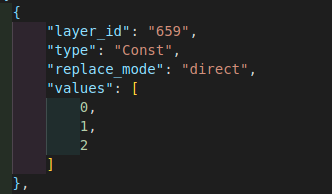 "npy": Load a Numpy binary file with the matrix output by np.save('xyz', a). The "values" attribute specifies the path to the Numpy binary file.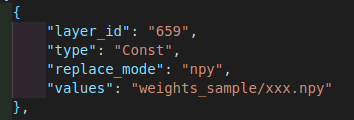 "insert_before": Add Transpose or Reshape or Cast just before the operation specified by layer_id.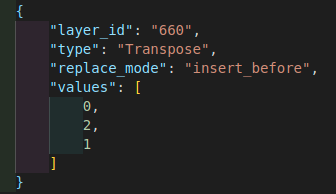 "insert_after": Add Transpose or Reshape or Cast just after the operation specified by layer_id.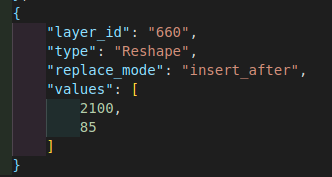 "change_axis": Changes the axis of the Concat or SoftMax attribute value.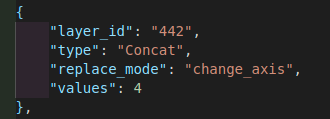 |
| 2-4 | values | Specify the value or the path to the Numpy binary file to replace the weight/constant value recorded in .bin. The way to specify is as described in the description of 'replace_mode'. The table below shows the correspondence between the strings that can be specified for the "Cast" operation and the TensorFlow types. In most cases, you will probably only use "i32", "i64", "f32", and "f16".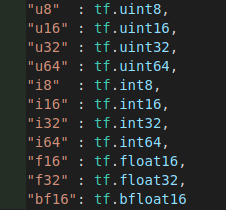 |
6-7-2. Example
- YOLOX Nano 320x320 (NCHW format)
- yolox_nano_320x320.xml
- yolox_nano_320x320.bin
- Let's assume that you don't need
Transposein the final layer of the model. Here you have[1, 85, 2100]as input, and the original OpenVINO model transposes[0, 2, 1]in that order to obtain the tensor[1, 2100, 85]. This figure shows the visualization of ayolox_nano_320x320.xmlfile using Netron. The number shown in theOUTPUTS-output-name:is the layer ID ofTranspose. The layer ID 660 is the number in the part before the colon. The number in the part after the colon is called the port number 2. However, what you are trying to change is the transposition parameter of theINPUTS-custom-name:part. The name of the parameter you are trying to change is625. Note that625is not a layer ID, just a name. - Check the model structure as recorded in .xml. First, open
yolox_nano_320x320.xmlin your favorite IDE. - Search for
to-layer="660"(Transpose) in the IDE. In the figure below, Layer ID658and Layer ID659are represented as input values connected to Layer ID660.
In the figure below, one of them is 658 and one of them is 659. It is difficult to determine exactly what it is from the image alone. You must again note that 658:3 in the image is only a name, not a layer ID. It is worth noting here that the type of value you want to replace is Const.
- Now you will search for layer ID
"658"in the IDE. The type is"Concat", so the desired layer was not this one. What you are looking for is"Const". - Now, search for layer ID
659in the IDE. The type is"Const". Now you can finally identify that the layer ID of the layer you want to replace is659. - Create a JSON file to replace the constants
[0, 2, 1]with[0, 1, 2], and you can use any name for the JSON file. Suppose you save the file with the namereplace.json. If you want to replace it with a numpy matrix, specify"npy"for"replace_mode":and the path to the.npyfile for"values":.
{
"format_version": 2,
"layers": [
{
"layer_id": "659",
"type": "Const",
"replace_mode": "direct",
"values": [
0,
1,
2
]
}
]
}
{
"format_version": 2,
"layers": [
{
"layer_id": "659",
"type": "Const",
"replace_mode": "npy",
"values": "path/to/your/xxx.npy"
}
]
}
- Specify the created JSON file as the argument of the
--weight_replacement_configparameter of the conversion command and execute it. This is the end of the explanation of how to replace weights and constants.
$ openvino2tensorflow \
--model_path yolox_nano_320x320.xml \
--output_saved_model \
--output_pb \
--output_no_quant_float32_tflite \
--weight_replacement_config replace.json
6-8. Check the contents of the .npy file, which is a binary version of the image file
$ view_npy --npy_file_path sample_npy/calibration_data_img_sample.npy
Press the Q button to display the next image. calibration_data_img_sample.npy contains 20 images extracted from the MS-COCO data set.
6-9. Sample image of a conversion error message
Since it is very difficult to mechanically predict the correct behavior of Transpose and Reshape, errors like the one shown below may occur. Using the information in the figure below, try several times to force the replacement of constants and weights using the --weight_replacement_config option #6-7-replace-weights-or-constant-values-in-const-op-and-add-transpose-or-reshape-or-cast-just-beforeafter-the-operation-specified-by-layer_id. This is a very patient process, but if you take the time, you should be able to convert it correctly.
6-10. Ability to specify an output layer for debugging the output values of the model
If you want to debug the output values of each layer, specify multiple layer IDs separated by commas in the --layerids_of_the_terminating_output option to check the output values. For example, if you want to debug the output values of two layers, LayerID=1007 (Add) and LayerID=1214 (Sigmoid), as shown in the figure below, specify as --layerids_of_the_terminating_output 1007,1214.
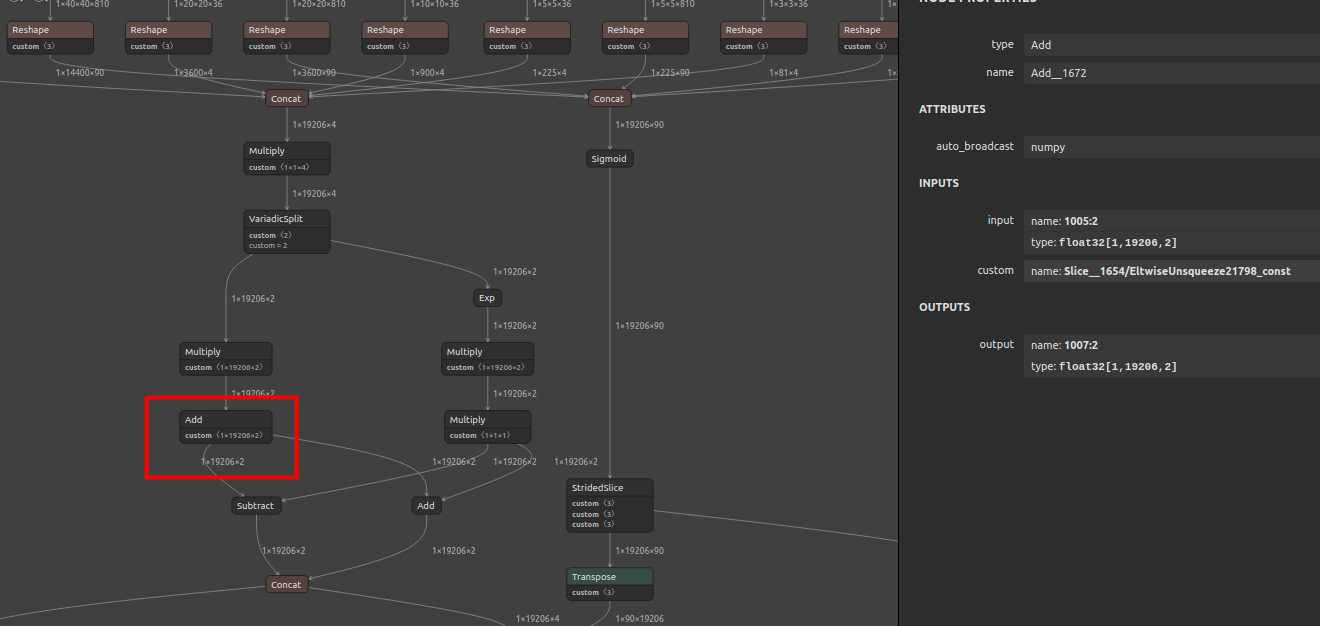
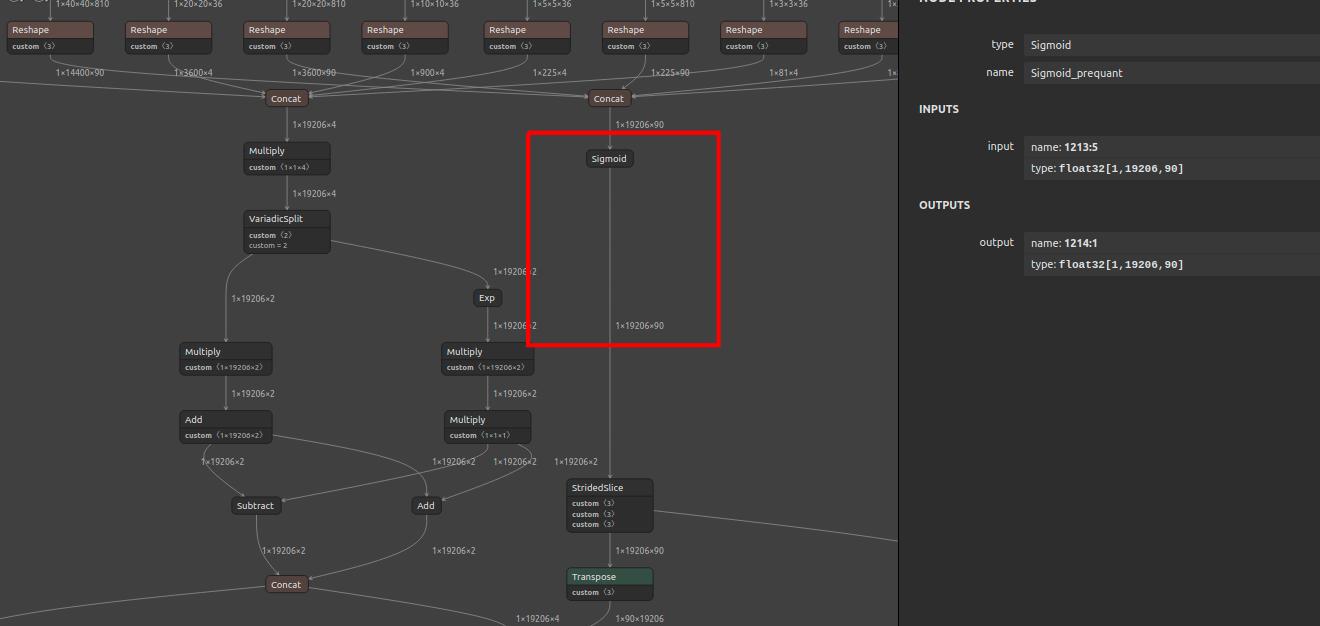
Split, VariadicSplit, TopK, or NonMaxSuppression, all output values will be used as outputs.
7. Output sample
8. Model Structure
https://digital-standard.com/threedpose/models/Resnet34_3inputs_448x448_20200609.onnx
| ONNX (NCHW) | OpenVINO (NCHW) | TFLite (NHWC) |
|---|---|---|
 |
 |
 |
9. My article
10. Conversion Confirmed Models
- u-2-net
- mobilenet-v2-pytorch
- midasnet
- footprints
- efficientnet-b0-pytorch
- efficientdet-d0
- dense_depth
- deeplabv3
- colorization-v2-norebal
- age-gender-recognition-retail-0013
- resnet
- arcface
- emotion-ferplus
- mosaic
- retinanet
- shufflenet-v2
- squeezenet
- version-RFB-320
- yolov4
- yolov4x-mish
- ThreeDPoseUnityBarracuda - Resnet34_3inputs_448x448
- efficientnet-lite4
- nanodet
- yolov4-tiny
- yolov5s
- yolact
- MiDaS v2
- MODNet
- Person Reidentification
- DeepSort
- DINO (Transformer)
Project details
Release history Release notifications | RSS feed
Download files
Download the file for your platform. If you're not sure which to choose, learn more about installing packages.
Source Distribution
Built Distribution
Hashes for openvino2tensorflow-1.25.1.tar.gz
| Algorithm | Hash digest | |
|---|---|---|
| SHA256 | b98b72c6c6a4e452101236e3e6b7bee60662a1f6ed5ef83888f069f094f127df |
|
| MD5 | ef68342bfd4357b0471d31221fb1d310 |
|
| BLAKE2b-256 | 2d5534739a365e2133a44d5d1fc3633c6629e7302504158f8b9bc78ca027d6b6 |
Hashes for openvino2tensorflow-1.25.1-py3-none-any.whl
| Algorithm | Hash digest | |
|---|---|---|
| SHA256 | 2f5eef7acca2f0612a01a8c2b5d361a18ae2e8741e463abd6b8b82cad2e7bdfe |
|
| MD5 | be324e0deb12914a12ca548384b3dd03 |
|
| BLAKE2b-256 | 08f78d0dee844eee9ee14157c1b92e4fed3ab4ae2d6ce5a3d8307106cb95b054 |





